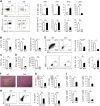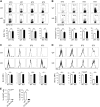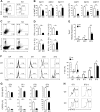PDCD5 regulates iNKT cell terminal maturation and iNKT1 fate decision
- PMID: 29921968
- PMCID: PMC6804728
- DOI: 10.1038/s41423-018-0059-2
PDCD5 regulates iNKT cell terminal maturation and iNKT1 fate decision
Abstract
Invariant natural killer T1 (iNKT1) cells are characterized by the preferential expression of T-box transcription factor T-bet (encoded by Tbx21) and the production of cytokine IFN-γ, but the relationship between the developmental process and iNKT1 lineage diversification in the thymus remains elusive. We report in the present study a crucial role of programmed cell death 5 (PDCD5) in iNKT cell terminal maturation and iNKT1 fate determination. Mice with T cell-specific deletion of PDCD5 had decreased numbers of thymic and peripheral iNKT cells with a predominantly immature phenotype and defects in response to α-galactosylceramide. Loss of PDCD5 also selectively abolished the iNKT1 lineage by reducing T-bet expression in iNKT cells at an early thymic developmental stage (before CD44 upregulation). We further demonstrated that TOX2, one of the high mobility group proteins that was highly expressed in iNKT cells at stage 1 and could be stabilized by PDCD5, promoted the permissive histone H3K4me3 modification in the promoter region of Tbx21. These data indicate a pivotal and unique role of PDCD5/TOX2 in iNKT1 lineage determination. They also suggest that the fate of iNKT1 may be programmed at the developmental stage of iNKT cells in the thymus.
Conflict of interest statement
The authors declare no competing interests.
Figures







Similar articles
-
iNKT cells require TSC1 for terminal maturation and effector lineage fate decisions.J Clin Invest. 2014 Apr;124(4):1685-98. doi: 10.1172/JCI69780. Epub 2014 Mar 10. J Clin Invest. 2014. PMID: 24614103 Free PMC article.
-
Transcriptional regulator Bhlhe40 works as a cofactor of T-bet in the regulation of IFN-γ production in iNKT cells.Proc Natl Acad Sci U S A. 2016 Jun 14;113(24):E3394-402. doi: 10.1073/pnas.1604178113. Epub 2016 May 25. Proc Natl Acad Sci U S A. 2016. PMID: 27226296 Free PMC article.
-
Serpinb1a Is Dispensable for the Development and Cytokine Response of Invariant Natural Killer T Cell Subsets.Front Immunol. 2020 Nov 11;11:562587. doi: 10.3389/fimmu.2020.562587. eCollection 2020. Front Immunol. 2020. PMID: 33262755 Free PMC article.
-
SLAM-SAP-Fyn: Old Players with New Roles in iNKT Cell Development and Function.Int J Mol Sci. 2019 Sep 27;20(19):4797. doi: 10.3390/ijms20194797. Int J Mol Sci. 2019. PMID: 31569599 Free PMC article. Review.
-
T Cell Receptor Expression Timing and Signal Strength in the Functional Differentiation of Invariant Natural Killer T Cells.Front Immunol. 2019 Apr 26;10:841. doi: 10.3389/fimmu.2019.00841. eCollection 2019. Front Immunol. 2019. PMID: 31080448 Free PMC article. Review.
Cited by
-
TOX2 coordinates with TET2 to positively regulate central memory differentiation in human CAR T cells.Sci Adv. 2023 Jul 21;9(29):eadh2605. doi: 10.1126/sciadv.adh2605. Epub 2023 Jul 19. Sci Adv. 2023. PMID: 37467321 Free PMC article.
-
Impaired thymic iNKT cell differentiation at early precursor stage in murine haploidentical bone marrow transplantation with GvHD.Front Immunol. 2023 Aug 3;14:1203614. doi: 10.3389/fimmu.2023.1203614. eCollection 2023. Front Immunol. 2023. PMID: 37600815 Free PMC article.
-
Retroviral Transduction of NKT Hybridoma Cells.Methods Mol Biol. 2021;2388:27-34. doi: 10.1007/978-1-0716-1775-5_3. Methods Mol Biol. 2021. PMID: 34524659
-
[rhPDCD5 suppresses pro-inflammatory cytokine secretion and proliferation and induces apoptosis of activated lymphocytes from rats with collagen-induced arthritis].Nan Fang Yi Ke Da Xue Xue Bao. 2019 Jun 30;39(6):627-632. doi: 10.12122/j.issn.1673-4254.2019.06.01. Nan Fang Yi Ke Da Xue Xue Bao. 2019. PMID: 31270039 Free PMC article.
-
Epigenetic Regulation of CD8+ Effector T Cell Differentiation by PDCD5.Eur J Immunol. 2025 Mar;55(3):e202451388. doi: 10.1002/eji.202451388. Eur J Immunol. 2025. PMID: 40111008 Free PMC article.
References
Publication types
MeSH terms
Substances
LinkOut - more resources
Full Text Sources
Other Literature Sources
Molecular Biology Databases
Miscellaneous

